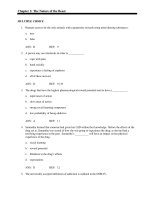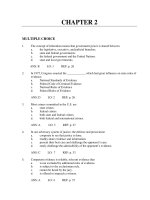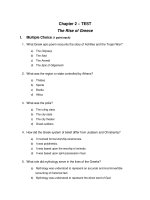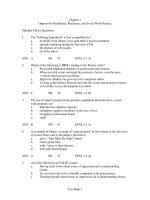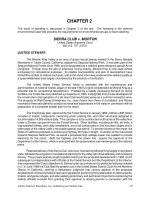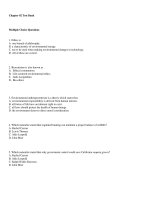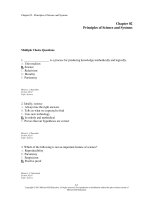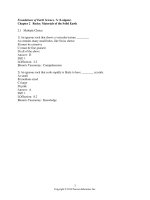Principles of environmental science 8th edition cunningham test bank
Bạn đang xem bản rút gọn của tài liệu. Xem và tải ngay bản đầy đủ của tài liệu tại đây (60.94 KB, 12 trang )
1. Systems function in cycles and consist of _________ that increase a process or component, and __________
that diminish a process or component.
A. positive feedback; negative feedback
B. open system; closed system
C. throughput; threshold
D. positive feedback; open system
E. balance; inbalance
Accessibility: Keyboard Navigation
Bloom's Level: 2. Understand
Chapter: 02
Section: 02.01
Topic: Science
2. A/An _________ is all forms of a single element that differs in atomic mass.
A. Isotope
B. Atom
C. Molecule
D. Element
Accessibility: Keyboard Navigation
Bloom's Level: 2. Understand
Chapter: 02
Section: 02.02
Topic: Chemistry
+
3. As the hydrogen ion [H ] concentration in a solution decreases, the hydroxide ion [OH ] concentration
A. increases and the pH increases.
B. increases and the pH decreases.
C. decreases and the pH increases.
D. decreases and the pH decreases.
E. decreases and the pH stays the same.
Accessibility: Keyboard Navigation
Bloom's Level: 2. Understand
Chapter: 02
Section: 02.02
Topic: Chemistry
4. Adding an acid to a solution _________ the pH, while adding a base _________ the pH.
A. decrease and neutralize.
B. increases and decreases.
C. neutralize and increases.
D. decreases and increase.
E. decreases and neutralize.
2-1
Accessibility: Keyboard Navigation
Bloom's Level: 2. Understand
Chapter: 02
Section: 02.02
Topic: Chemistry
5. _________ is an example of something that has a basic pH.
A. Tomato Juice
B. Ammonia
C. Milk
D. Saliva
E. Coffee
Accessibility: Keyboard Navigation
Bloom's Level: 2. Understand
Chapter: 02
Section: 02.02
Topic: Chemistry
6. The damage to an ecosystem caused by a hurricane or flood can be referred to as
A.
B.
C.
D.
E.
An open system
An emergent property
Equilibrium in nature
A disturbance
Negative feedback loop
Accessibility: Keyboard Navigation
Bloom's Level: 1. Remember
Chapter: 02
Section: 02.02
Topic: Science
7. The relationship among atoms, elements, and compounds is most like the relationship among which of the
following groupings
A.
B.
C.
D.
E.
bricks, brick houses, and large brick buildings.
grains of sand, rocks, and continents.
bricks, sidewalks, and paved roads.
ponds, lakes, and oceans.
grains of sugar, sugar, and sweetened iced tea.
Accessibility: Keyboard Navigation
Bloom's Level: 3. Apply
Chapter: 02
Section: 02.02
Topic: Chemistry
2-2
8. Which of the following is not a molecule?
A. O3
B. O2
C. C
D. DNA
E. H2O
Accessibility: Keyboard Navigation
Bloom's Level: 2. Understand
Chapter: 02
Section: 02.02
Topic: Chemistry
9. Which of the following statements would change this into a true statement: "Most, but not all, living organisms are made
up of organic compounds"?
A. All living organisms are made up of organic compounds.
B. All living organisms are made up of inorganic compounds.
C. Most, but not all, living organisms are made up of inorganic compounds.
D. Most, but not all, living organisms are made up of organic elements.
E. Most, but not all, living organisms are made up of inorganic elements.
Accessibility: Keyboard Navigation
Bloom's Level: 2. Understand
Chapter: 02
Section: 02.02
Topic: Chemistry
10. Energy is the ability to
A.
B.
C.
D.
E.
move objects.
become heated.
transfer heat from one object to another.
All of these are true.
Both move objects and transfer heat from one object to another are true.
Accessibility: Keyboard Navigation
Bloom's Level: 1. Remember
Chapter: 02
Section: 02.03
Topic: Energy
11. Potential energy is _______ energy.
A.
B.
C.
D.
E.
electrical
motion
stored
heat
latent
Accessibility: Keyboard Navigation
Bloom's Level: 1. Remember
Chapter: 02
Section: 02.03
Topic: Energy
2-3
12. The motion of a rock rolling downhill is known as __________ energy.
A. kinetic
B. latent
C. potential
D. electrical
E. mechanical
Accessibility: Keyboard Navigation
Bloom's Level: 1. Remember
Chapter: 02
Section: 02.03
Topic: Energy
13. Metabolism can be seen as the process of converting
A.
B.
C.
D.
E.
energy into matter.
potential energy into kinetic energy.
kinetic energy into potential energy.
atoms into compounds.
matter into potential energy.
Accessibility: Keyboard Navigation
Bloom's Level: 3. Apply
Chapter: 02
Section: 02.03
Topic: Energy
14. The law of conservation of matter tells us that matter
A.
B.
C.
D.
E.
can never be reused.
needs to be conserved or it will not be available for future generations.
can be destroyed.
can be conserved by some adaptive strategies.
is used repeatedly.
Accessibility: Keyboard Navigation
Bloom's Level: 2. Understand
Chapter: 02
Section: 02.02
Topic: Chemistry
15. What implication(s) does the law of conservation of matter have for humans?
A.
B.
C.
D.
E.
We cannot create energy because it is neither created nor destroyed.
As matter is recycled it loses some of its integrity so we need to be careful when we dispose of goods.
Natural resources are unlimited because they are used and reused by living organisms.
Disposable goods are not going "away" when we throw them out.
All of these are implications of the law of conservation of matter.
Accessibility: Keyboard Navigation
Bloom's Level: 2. Understand
Chapter: 02
Section: 02.02
Topic: Chemistry
2-4
16. The first law of thermodynamics and the law of conservation of matter are similar in that
A. under normal circumstances neither energy nor matter is created nor destroyed.
B. both energy and matter are recycled through biological systems.
C. both energy and matter flow in a one-way path through biological systems.
D. under normal circumstances energy and matter are destroyed as they pass through biological systems.
E. The first law of thermodynamics and the law of conservation of matter are not similar.
Accessibility: Keyboard Navigation
Bloom's Level: 1. Remember
Chapter: 02
Section: 02.03
Topic: Energy
17. What implication(s) does the second law of thermodynamics have for biological systems?
A.
B.
C.
D.
E.
Systems cannot create energy because energy is neither created nor destroyed.
With each transformation, less available energy is available to do work so older systems have less energy.
A constant supply of energy is necessary for maintenance of biological systems.
Energy is unlimited because it is used and reused by living organisms.
None of these is an implication of the second law of thermodynamics.
Accessibility: Keyboard Navigation
Bloom's Level: 1. Remember
Chapter: 02
Section: 02.03
Topic: Energy
18. Photosynthesis is the process of converting __________ into __________ energy.
A.
B.
C.
D.
E.
chemical bond energy; kinetic
solar energy; chemical bond
solar energy; kinetic
solar electrical energy; heat
chemical bond energy; potential
Accessibility: Keyboard Navigation
Bloom's Level: 1. Remember
Chapter: 02
Section: 02.04
Topic: Photosynthesis
19. Photosynthesis produces sugars from
A. water, carbon dioxide, and energy.
B. water, other sugars, and oxygen.
C. oxygen, carbon dioxide, and water.
D. carbon dioxide, enzymes, and energy.
E. oxygen, water, and energy.
Accessibility: Keyboard Navigation
Bloom's Level: 1. Remember
Chapter: 02
Section: 02.04
Topic: Photosynthesis
2-5
20. The process of photosynthesis and cellular respiration are similar in that they both
A.
B.
C.
D.
E.
capture energy in the form of sugar.
occur in all living organisms.
temporarily store energy in chemical bonds.
capture energy from the sun.
none of these are correct.
Accessibility: Keyboard Navigation
Bloom's Level: 2. Understand
Chapter: 02
Section: 02.04
Topic: Photosynthesis
21. The process of cellular respiration
A.
B.
C.
D.
E.
helps primary producers store energy accumulated by chloroplasts.
releases energy from chemical bonds of molecules such as glucose.
eliminates the need for enzymes in metabolism.
does not occur in primary producers.
does not occur in detritivores.
Accessibility: Keyboard Navigation
Bloom's Level: 1. Remember
Chapter: 02
Section: 02.04
Topic: Cellular Respiration
22. All members of a species that live in the same area at the same time make up a(an)
A.
B.
C.
D.
E.
species.
ecosystem.
community.
population.
biome.
Accessibility: Keyboard Navigation
Bloom's Level: 1. Remember
Chapter: 02
Section: 02.05
Topic: Populations
23. A biological community consists of all
A. populations living and interacting in an area.
B. members of a species living in the same area.
C. living things on Earth.
D. populations of a given species.
E. members of a species living in the same biome.
Accessibility: Keyboard Navigation
Bloom's Level: 1. Remember
Chapter: 02
Section: 02.05
Topic: Communities
2-6
24. An ecosystem consists of
A.
B.
C.
D.
E.
a physical environment within which a biological community lives.
the species with which a biological community interacts.
a biological community and its physical environment.
the primary producers within a biological community.
all the species in a biological community.
Accessibility: Keyboard Navigation
Bloom's Level: 1. Remember
Chapter: 02
Section: 02.05
Topic: Ecosystems
25. The length and complexity of a food web in the Arctic would be ____________ when compared to one in the tropical
rainforest.
A. short and less complex
B. short and more complex
C. long and less complex
D. long and more complex
E. about the same
Accessibility: Keyboard Navigation
Bloom's Level: 3. Apply
Chapter: 02
Section: 02.05
Topic: Trophic Levels
26. Producers rely on the process of ____________ to release chemical energy and consumers rely on the process of
____________ to release chemical energy.
A.
B.
C.
D.
E.
cellular respiration; photosynthesis
cellular respiration; cellular respiration
photosynthesis; cellular respiration
photosynthesis; photosynthesis
the sun; the sun
Accessibility: Keyboard Navigation
Bloom's Level: 2. Understand
Chapter: 02
Section: 02.05
Topic: Trophic Levels
27. Primary consumers are also known as
A.
B.
C.
D.
E.
carnivores.
scavengers.
decomposers.
herbivores.
top carnivores
Accessibility: Keyboard Navigation
Bloom's Level: 1. Remember
Chapter: 02
Section: 02.05
Topic: Trophic Levels
2-7
28. Energy enters a system as sunlight and a producer is able to produce 10 kilograms of tissue. If eaten, the
producer would produce about ______ kilograms of consumer tissue that would provide about __________
kilograms of tissue for a secondary consumer.
A.
B.
C.
D.
E.
100; 10
10; 1
100; 1
1; 0.1
10; 0.1
Accessibility: Keyboard Navigation
Bloom's Level: 3. Apply
Chapter: 02
Section: 02.05
Topic: Trophic Levels
29. Living plants and the ocean are known as "carbon sinks" because
A.
B.
C.
D.
E.
they are made of carbon.
they create carbon.
they destroy carbon.
they store carbon.
due to gravity, carbon is found closer to the ground.
Accessibility: Keyboard Navigation
Bloom's Level: 2. Understand
Chapter: 02
Section: 02.06
Topic: Biogeochemical Cycles
30. _______________________ are characteristics of an entire system that are greater than the sum of its parts.
A.
B.
C.
D.
E.
Open systems
Closed systems
Disturbances
Emergent properties
Feedback loops
Accessibility: Keyboard Navigation
Bloom's Level: 1. Remember
Chapter: 02
Section: 02.01
Topic: Ecosystems
31. Which is the best example of a closed system?
A. a space station
B. a forest
C. a hotel
D. a lake
E. a river
Accessibility: Keyboard Navigation
Bloom's Level: 3. Apply
Chapter: 02
Section: 02.01
Topic: Ecosystems
2-8
32. Which is not a characteristic of acids?
A.
B.
C.
D.
E.
they readily give up hydrogen ions
they have a pH of less than 7
they react easily with living tissue
they react easily with nonliving minerals
all of these are characteristic of acids
Accessibility: Keyboard Navigation
Bloom's Level: 1. Remember
Chapter: 02
Section: 02.02
Topic: Chemistry
33. How do the organisms living around Yellowstone's hot springs get energy?
A.
B.
C.
D.
E.
by eating alga
from the heat in the hot spring
from photosynthesis
from chemosynthesis
no organisms can live at the depths of black smokers
Accessibility: Keyboard Navigation
Bloom's Level: 1. Remember
Chapter: 02
Section: 02.04
Topic: Energy
34. Nitrogen is an essential component of amino acids and proteins.
TRUE
Accessibility: Keyboard Navigation
Bloom's Level: 1. Remember
Chapter: 02
Section: 02.02
Topic: Chemistry
35. Photosynthesis is a step in the global nitrogen cycle.
FALSE
Accessibility: Keyboard Navigation
Bloom's Level: 2. Understand
Chapter: 02
Section: 02.04
Topic: Photosynthesis
36. Water expands when it crystallizes and freezes.
TRUE
Accessibility: Keyboard Navigation
Bloom's Level: 1. Remember
Chapter: 02
Section: A Water Planet
Topic: Properties of Water
2-9
37. Based on what you know of photosynthesis, what effect would clearcutting of large forests have on the amount of
carbon dioxide in the atmosphere?
A. It would increase the level of carbon dioxide since less photosynthesis would be taking place.
B. The amount of carbon dioxide would be decreased since the trees would no longer be living.
C. There would be no change in carbon dioxide levels since humans put carbon dioxide into the atmosphere by
burning fossil fuels.
D. The amount of carbon dioxide would be the same since the reaction rates of photosynthesis and respiration are
equal.
Accessibility: Keyboard Navigation
Bloom's Level: 5. Evaluate
Chapter: 02
Section: 02.04
Topic: Photosynthesis
38. If you were to remove the top predator in a food web or food chain
A. there would be an increase in the number of producers.
B. the producer population will be depleted because there are more primary consumers or herbivores.
C. another predator would move in and take its place as top predator.
D. there would be no change in the exchange of energy since predators get very little (only 10%) of the energy from their
food source.
Accessibility: Keyboard Navigation
Bloom's Level: 3. Apply
Chapter: 02
Section: 02.05
Topic: Trophic Levels
39. Which biogeochemical cycle lacks an atmospheric component?
A. The hydrologic cycle.
B. The carbon cycle.
C. The nitrogen cycle.
D. The phosphorous cycle.
Accessibility: Keyboard Navigation
Bloom's Level: 2. Understand
Chapter: 02
Section: 02.06
Topic: Biogeochemical Cycles
40. Water supplies contaminated with algae that produce toxins making the water unfit to drink is a result of the
human impact to the
A.
B.
C.
D.
hydrologic cycle.
carbon cycle.
nitrogen cycle.
sulfur cycle.
Accessibility: Keyboard Navigation
Bloom's Level: 3. Apply
Chapter: 02
Section: 02.06
Topic: Biogeochemical Cycles
2-10
41. The amount of biomass that is produced in an area during a given time would be referred to as
A.
B.
C.
D.
production.
nutrient load.
chemosynthesis.
productivity.
Accessibility: Keyboard Navigation
Bloom's Level: 1. Remember
Section: 02.05
Topic: Trophic Levels
42. Organisms that live in deep sea ocean vents use chemicals rather than sunlight to drive the energy producing
reactions. These organisms undergo what process?
A.
B.
C.
D.
Photosynthesis
Biosynthesis
Accumulation
Chemosynthesis
Accessibility: Keyboard Navigation
Bloom's Level: 2. Understand
Section: 02.04
Topic: Photosynthesis
43. Humans alter the sulfur cycle by
A. burning fossil fuels.
B. mining rock.
C. applying too much fertilizer to crop fields.
D. clear cutting tropical forests.
Accessibility: Keyboard Navigation
Bloom's Level: 2. Understand
Section: 02.06
Topic: Biogeochemical Cycles
2-11
Category
Accessibility: Keyboard Navigation
Bloom's Level: 1. Remember
Bloom's Level: 2. Understand
Bloom's Level: 3. Apply
Bloom's Level: 5. Evaluate
Chapter: 02
Section: A Water Planet
Section: 02.01
Section: 02.02
Section: 02.03
Section: 02.04
Section: 02.05
Section: 02.06
Topic: Biogeochemical Cycles
Topic: Cellular Respiration
Topic: Chemistry
Topic: Communities
Topic: Ecosystems
Topic: Energy
Topic: Photosynthesis
Topic: Populations
Topic: Properties of Water
Topic: Trophic Levels
Topic: Science
2-12
